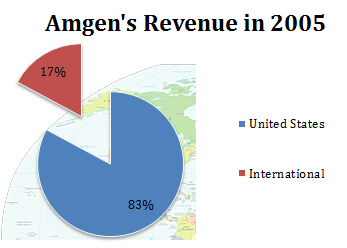Where Amgen Is Finding Its Growth
In today's world, most companies span several regions and sell across the world. As Foolish colleague Morgan Housel notes, 10 years ago, less than a third of S&P 500 revenue came from abroad. Today, that makes up half the S&P's sales and continues to grow.
The truth is, investors regularly underestimate how much demand comes from abroad. More importantly, for large, multinational corporations that have already established a presence in their home markets, much of their future growth comes from abroad.
With that in mind, today we're looking at Amgen (NAS: AMGN) . We'll examine not only where its sales and earnings come from, but how its sales abroad have changed over time.
Where Amgen's sales were five years ago
Five years ago, Amgen collected 83% of its sales from the United States.

Source: S&P Capital IQ.
Where Amgen's sales are today
Today, Amgen collects 77% of its sales from the United States. That's still a vast majority of sales, but over the past five years nearly all of the company's growth has been from international sales.

Segment | 5-Year Sales Growth |
|---|---|
United States | 13% |
International | 60% |
Companywide | 21% |
Source: S&P Capital IQ.
Being so heavily skewed to the United States market gave the company plenty of opportunity to expand in other developed markets, like Europe and Canada, and the result was international growth over the past half-decade. However, there are some coming threats to Amgen's rapid international expansion. Generic biosimilars to key drugs Epogen and Neupogen are putting pressure on Amgen. While the company has managed to successfully battle many of these generics in recent years, they could slow international expansion in the years to come.
Competitor checkup
One last point to check is how Amgen's footprint compares with some of its peers and industry rivals:
Company | Geography With Most Sales | Percent of Sales |
|---|---|---|
Amgen | United States | 77% |
Warner Chilcott (NAS: WCRX) | North America | 81% |
Teva Pharmaceutical (NAS: TEVA) | North America | 62% |
Novartis (NYS: NVS) | The Americas | 31%* |
Source: S&P Capital IQ. * Novartis' largest reported segment is The Americas. If it reported Europe as a block segment instead of breaking down individual countries, that would likely be its largest market.
Industrywide trends like regulatory pathways for generic biologic drugs could have opposite effects for Amgen and its competitors in the table above. For example, Novartis' generic Sandoz division would benefit from generics having an easier path to the market. Overall, if you're a health-care investor, Amgen presents a far more concentrated bet on the United States market compared to large peers like Johnson & Johnson or Pfizer.
Keep searching
If you're looking to stay updated on Amgen or any other companies listed above, make sure to add them to our free watchlist service, My Watchlist. It's free, and it helps you constantly stay updated on news and analysis on your favorite companies.
Add Amgen to My Watchlist.
Add Warner Chilcott to My Watchlist.
Add Teva Pharmaceutical to My Watchlist.
Add Novartis AG to My Watchlist.
At the time thisarticle was published Eric Bleeker owns shares of no companies listed above. You can follow him on Twitter to see all of his technology and market commentary. The Motley Fool owns shares of Teva Pharmaceutical Industries and Johnson & Johnson. Motley Fool newsletter services have recommended buying shares of Novartis, Pfizer, Teva Pharmaceutical Industries, and Johnson & Johnson. Motley Fool newsletter services have recommended creating a diagonal call position in Johnson & Johnson. Try any of our Foolish newsletter services free for 30 days. We Fools may not all hold the same opinions, but we all believe that considering a diverse range of insights makes us better investors. The Motley Fool has a disclosure policy.
Copyright © 1995 - 2011 The Motley Fool, LLC. All rights reserved. The Motley Fool has a disclosure policy.

